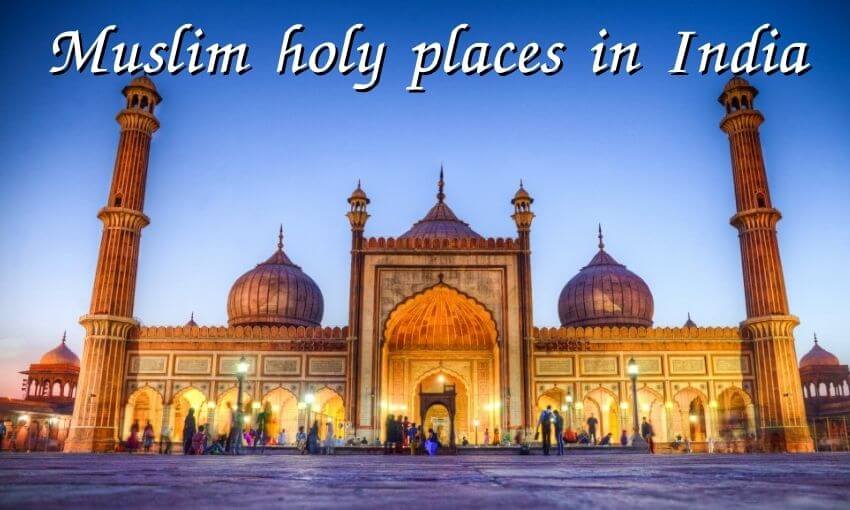About Muslim holy places in India. India is home to a number of Muslim holy places, which are revered by millions of Muslims around the world. These places are important to the Islamic faith and are visited by pilgrims from all over the world. From the grand mosques of Delhi to the ancient shrines of Ajmer, these places are a testament to the rich history and culture of India’s Muslim population. In this article, we will explore some of the most important Muslim holy places in India and their significance to the Islamic faith.

The Significance of the Hazratbal Shrine in Kashmir (Muslim Holy Places In India)
The Hazratbal Shrine in Kashmir is a place of immense significance for the people of the region. It is a revered site for Muslims, as it is believed to house a relic of the Prophet Muhammad. This relic is believed to be a strand of his hair, and it is kept in a special chamber within the shrine.
The Hazratbal Shrine is a place of pilgrimage for many Muslims, and it is also a place of great spiritual significance. People come to the shrine to pray and seek blessings from the Prophet Muhammad. It is also a place of great historical importance, as it is believed to have been built in the 16th century.
The Hazratbal Shrine is also a symbol of Kashmiri’s identity. It is a reminder of the region’s rich cultural heritage and its long history of religious tolerance. A shrine is a place where people of all faiths can come together to celebrate their shared beliefs and values.
Hazratbal Shrine Muslim place:
The Hazratbal Shrine is also a place of great political significance. It has been the site of many protests and demonstrations over the years, as people have sought to express their grievances and to demand their rights. The shrine has also been the site of some of the most violent clashes between Indian security forces and Kashmiri separatists.
The Hazratbal Shrine is a place of immense significance for the people of Kashmir. It is a place of pilgrimage, spiritual significance, historical importance, and political significance. It is a reminder of the region’s rich cultural heritage and its long history of religious tolerance. It is a place where people of all faiths can come together to celebrate their shared beliefs and values.
Exploring the Islamic Architecture of the Jama Masjid in Delhi (Muslim Holy Places In India)
The Jama Masjid in Delhi is a stunning example of Islamic architecture. Built-in the 17th century by Mughal Emperor Shah Jahan, it is one of the largest mosques in India and a major tourist attraction. The mosque is a beautiful blend of Islamic and Indian architectural styles, and its intricate details are a testament to the skill of the artisans who created it.
The mosque is built on a raised platform, with a large courtyard surrounded by four minarets. The main prayer hall is located in the center of the courtyard and is covered by three large domes. The domes are decorated with intricate geometric patterns and inscriptions from the Quran. The walls of the mosque are also decorated with intricate carvings and calligraphy.
Mosque Muslim place:
The mosque is also known for its impressive marble inlay work. The walls and floors of the mosque are decorated with intricate patterns of marble inlays, which are made up of thousands of pieces of marble. The marble inlays are a combination of geometric patterns and floral designs, and they create a stunning visual effect.
The Jama Masjid is also known for its impressive use of light. The mosque is illuminated by hundreds of lamps, which create a beautiful atmosphere in the evening. The mosque also has a large number of windows, which allow natural light to enter the building.
The Jama Masjid is a stunning example of Islamic architecture, and it is a must-see for anyone visiting Delhi. Its intricate details and impressive use of light make it a truly unique and beautiful building. It is a testament to the skill of the artisans who created it, and it is a reminder of the rich history of the Mughal Empire.
Visiting the Tomb of the Sufi Saint Moinuddin Chishti in Ajmer (Muslim Holy Places In India)
Visiting the Tomb of the Sufi Saint Moinuddin Chishti in Ajmer is an experience like no other. This holy shrine is a place of immense spiritual significance, and it is easy to feel the presence of the saint in the atmosphere. The tomb is located in the heart of the city, and it is surrounded by a large courtyard. The entrance to the shrine is marked by two large gates, and the walls are adorned with intricate carvings and colorful tiles.
The shrine, the atmosphere is peaceful and serene:
Inside the shrine, the atmosphere is peaceful and serene. The tomb is surrounded by a marble platform, and it is covered with a green cloth. The walls are decorated with verses from the Quran, and the air is filled with the scent of incense. There is a sense of reverence and awe in the air, and it is easy to feel the presence of the saint.
The shrine is also home to a number of other shrines, including those dedicated to the saint’s family members. There is also a mosque located within the complex, and it is a popular place for prayer and meditation.
Visiting the Tomb of the Sufi Saint Moinuddin Chishti in Ajmer is an experience that will stay with you for a lifetime. It is a place of immense spiritual significance, and it is easy to feel the presence of the saint in the atmosphere. A shrine is a place of peace and serenity, and it is a reminder of the power of faith and devotion.
The History and Significance of the Ajmer Sharif Dargah (Muslim Holy Places In India)
The Ajmer Sharif Dargah is a shrine located in the city of Ajmer in Rajasthan, India. It is one of the most important pilgrimage sites for Muslims in India and is visited by millions of devotees every year. The shrine is dedicated to the Sufi saint Khwaja Moinuddin Chishti, who is also known as “Gharib Nawaz” or “Benefactor of the Poor”.
The Ajmer Sharif Dargah is believed to have been established in the 12th century by the Sufi saint Khwaja Moinuddin Chishti. He was a renowned scholar and mystic who traveled from Persia to India in search of spiritual enlightenment. He settled in Ajmer and established a khanqah (a Sufi monastery) where he preached his teachings and attracted a large number of followers.
Shrine is a symbol of communal harmony:
The shrine is a symbol of communal harmony and is revered by people of all faiths. Hindus, Muslims, Sikhs, and Christians all visit the shrine to pay their respects to the saint. The shrine is also a popular destination for tourists from all over the world who come to experience the spiritual atmosphere of the place.
The Ajmer Sharif Dargah is an important pilgrimage site for Muslims in India. It is believed that the saint’s blessings can cure any illness and fulfill any wish. Devotees come to the shrine to offer prayers and seek blessings from the saint. The shrine also holds an annual Urs festival, which is attended by millions of devotees from all over the world.
The Ajmer Sharif Dargah is a symbol of communal harmony and is a reminder of the importance of tolerance and respect for all religions. It is a place where people of all faiths can come together in peace and harmony. The shrine is a testament to the power of faith and the importance of spiritual enlightenment.
Exploring the Sacred Sites of Islam in India (Muslim Holy Places In India)
India is home to some of the most sacred sites of Islam, and exploring them can be a truly enlightening experience. From the grandeur of the Taj Mahal to the serenity of the Ajmer Sharif Dargah, these sites are a testament to the rich history of the Islamic faith in India.
Taj Mahal:
The Taj Mahal is perhaps the most iconic of all the Islamic sites in India. Built by Mughal emperor Shah Jahan in memory of his beloved wife Mumtaz Mahal, the Taj Mahal is a stunning example of Mughal architecture. The white marble mausoleum is surrounded by lush gardens and is a popular tourist destination. The Taj Mahal is a symbol of love and devotion, and it is a must-visit for anyone exploring the Islamic sites of India.
The Ajmer Sharif Dargah is another important Islamic site in India. Located in the city of Ajmer in Rajasthan, the Dargah is a shrine dedicated to the Sufi saint Moinuddin Chishti. The Dargah is a popular pilgrimage site for Muslims, and it is believed that those who visit the shrine will be blessed with good fortune. The Dargah is also a popular tourist destination, and visitors can explore the complex and its many shrines and tombs.
Jama Masjid in Delhi:
The Jama Masjid in Delhi is another important Islamic site in India. Built by Mughal emperor Shah Jahan in the 17th century, the Jama Masjid is one of the largest mosques in India. The mosque is a popular pilgrimage site for Muslims, and it is also a popular tourist destination. Visitors can explore the mosque and its many courtyards and minarets.
Badshahi Mosque in Lahore:
The Badshahi Mosque in Lahore is another important Islamic site in India. Built by Mughal emperor Aurangzeb in the 17th century, the Badshahi Mosque is one of the largest mosques in the world. The mosque is a popular pilgrimage site for Muslims, and it is also a popular tourist destination. Visitors can explore the mosque and its many courtyards and minarets.
Exploring the sacred sites of Islam in India can be a truly enlightening experience. From the grandeur of the Taj Mahal to the serenity of the Ajmer Sharif Dargah, these sites are a testament to the rich history of the Islamic faith in India. Whether you are a pilgrim or a tourist, these sites are sure to leave you with a lasting impression.
Conclusion
In conclusion, Muslim holy places in India are an important part of the country’s cultural and religious heritage. They are a source of spiritual and cultural enrichment for the people of India, and they are a reminder of the long and rich history of the Muslim community in India. These places of worship are a testament to the strong bond between the Muslim community and the Indian people, and they are a reminder of the importance of religious tolerance and understanding.
Content from other States:
- No items




